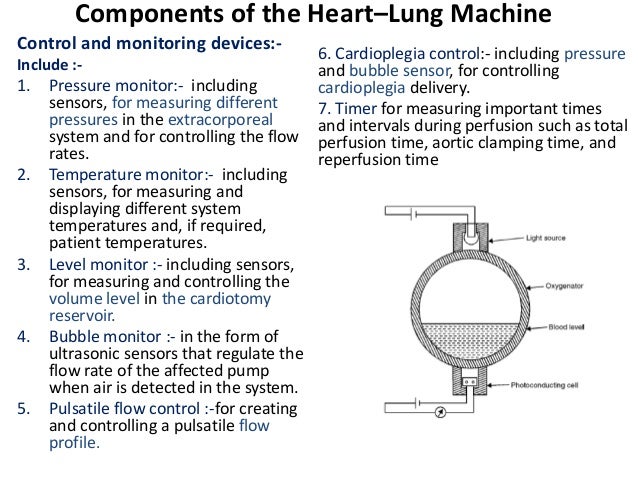Heart Lung Machine
Heart Lung Machine (HLM):
- A heart-lung machine is a device called a cardiopulmonary bypass used to provide temporary mechanical circulatory support.
- HLM(heart-lung machine) is a device that provides blood circulation and oxygenation while the heart is stopped.
- It is a means of keeping a patient alive while his/her heart is stopped or even removed from the body.
- Indicating its function as a substitute for the normal functions of the heart (cardio) and lungs (pulmonary).
- It is the heart's function to provide blood circulation at all times. It pushes blood out into the body and through the lungs.
- It must function every minute of every day of life to maintain the health of the tissues throughout the body.
- Cardioplegia
- Cannula
- Blood Reservoir
- Heparin Pumps
- Roller pumps/Centrifugal pump
- Oxygenators
- Heat exchangers
Block Diagram:

1. Cardioplegia
Heart-lung machine circuit consists of a separate circuit for infusing a solution into the heart itself to produce cardioplegia to stop the heart from beating, and to provide myocardial protection (to prevent the death of heart tissue).
2. Cannula
A venous cannula removes oxygen-deprived blood from a patient's body. An arterial cannula is sewn into a patient's body and is used to infuse oxygen-rich blood.
A cardioplegia cannula is sewn into the heart to deliver a cardioplegia solution to cause the heart to stop beating.
3. Blood reservoir
The blood reservoir serves as a receiving chamber for venous return, facilitates a venous bubble trap, provides a convenient place to add drugs, fluids, or blood, and adds storage capacity for the perfusion system.
Reservoirs may be rigid (hard) plastic or soft, collapsible plastic bags.
4. Heparin Pump
Once using a heart-lung machine during open-heart surgery, A powerful anticoagulant, Heparin should be given to the patient in order to reduce the blood's ability to clot, reducing the risk of clots forming in the heart-lung machine.
5. Pumping system
i) Roller pumps
Roller pumps compress a segment of the blood-filled tubing. Blood is then pushed ahead of the moving roller.
Roller pumps consist of tubing, which is compressed by two rollers 180° apart. Forward flow is generated by roller compression and the flow rate depends upon the diameter of the tubing and the rate of rotation.
Excessive compression of the tubing in a roller pump increases the risk of hemolysis.
ii) Centrifugal pump
Centrifugal pumps have replaced roller pumps at many institutions; mainly because they cannot over-pressurize the heart-lung machine system.
It consists of smooth plastic cones, which when rotated rapidly, propel blood by centrifugal force. An arterial flow meter is required to determine forward blood flow, which varies with the speed of rotation and the afterload of the arterial line.
6. Oxygenators
Oxygenators not only supply vital oxygen for the blood but also transport carbon dioxide, anesthetics and other gases into and out of circulation.
There are three types of oxygenator
1. Membrane oxygenators
2. Bubble oxygenator
3. Film oxygenator
1. Membrane oxygenators
Membrane oxygenators imitate the natural lung by a thin membrane of either microporous polypropylene or silicone rubber between the gas and blood phases.

2. Bubble oxygenator
The bubble oxygenator's venous blood drains directly into an Oxygenator chamber into which oxygen is infused through a diffusion plate. The diffusion plate produces thousands of small oxygen bubbles within the blood. Gas exchange occurs across a thin film at the blood-gas interface around each bubble. Carbon dioxide diffuses into the bubble and oxygen diffuses outward into the blood.
7. Heat Exchanger
Control body temperature by heating or cooling blood passing through the perfusion circuit.
In the heat exchanger, blood flows through spiraling coils made of stainless steel. The inner walls of the coils are coated with polymers to limit blood-surface interactions. The circulating water is chilled to nearly o °C in an ice bath and heated by an electric resistance coil to an absolute maximum of 42 °C.

Schmatic setup of heart lung mechine
Stopping of Heart-lung machine
Once the operation is completed, The surgeon gradually occludes the arterial pressure and pulse, and central venous pressure is monitored and adjusted. When cardiac performance is satisfactory and stable, protamine is given to reverse cardioplegia and blood return from the surgical field is discontinued.
Complications
- Hemolysis
- Capillary leak syndrome
- Clotting of blood in the circuit - can block the circuit or send a clot into the patient.
- Air embolism
- Leakage - loss of blood perfusion of tissue if a line becomes disconnected.
- 1.5% of patients that undergo Heart-lung machines are at risk of developing Acute Respiratory Distress Syndrome.


Oi spr pa
ReplyDelete